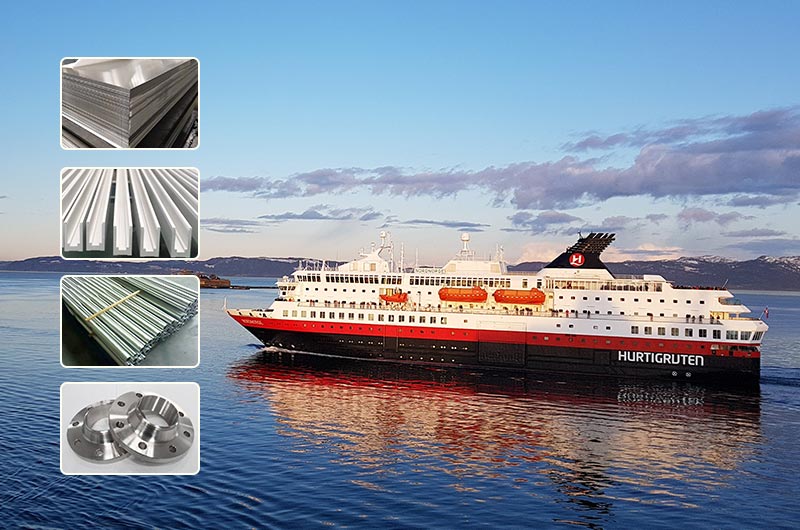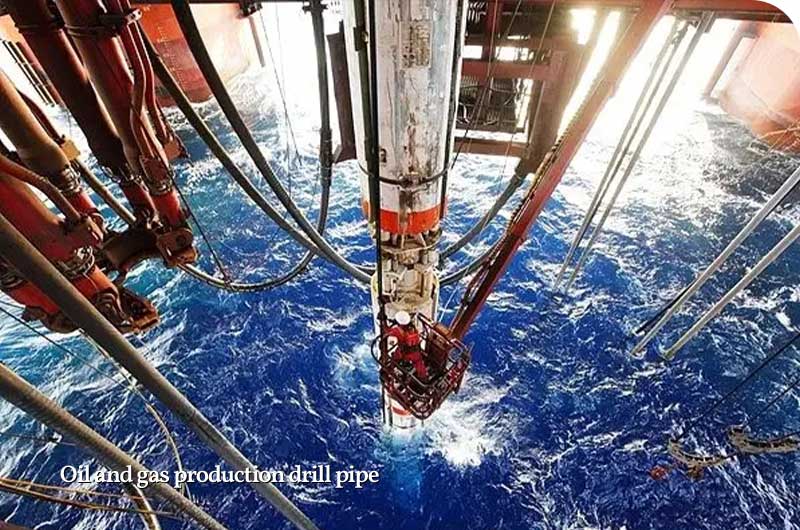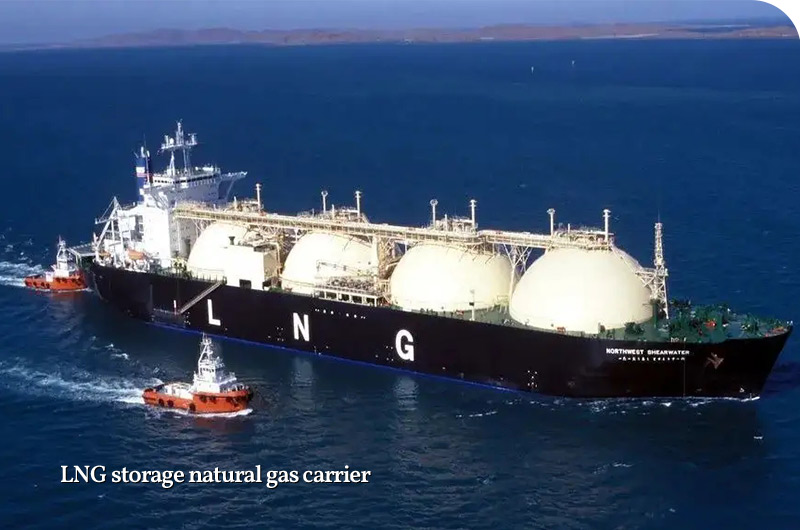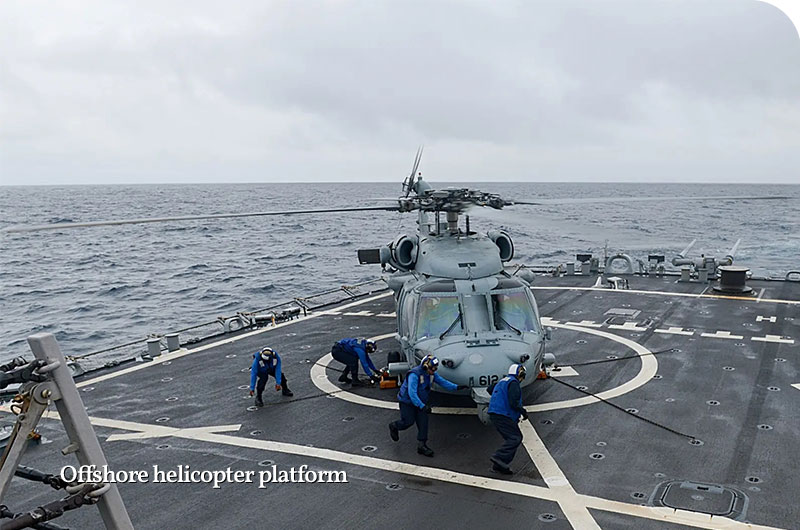Aluminum material has the characteristics of light weight, strong corrosion resistance, high strength and good impact resistance. Realize energy saving, consumption reduction and emission reduction. The use of aluminum alloy materials to manufacture drill pipes in offshore engineering can prolong the service life of drilling equipment and is widely used in the construction of marine infrastructure.
Advantages of aluminum alloy material materials in ships and marine engineering
Aluminum alloy material has the characteristics of low specific gravity, elastic modulus, corrosion resistance, weld ability, easy processing, non-magnetic and good low temperature characteristics. When it is applied to ship construction, it mainly has the following advantages.
- Due to its low specific gravity, it can reduce the weight of the boat. This can reduce the power of the power equipment and ensure the speed.
- Reduce fuel consumption, improve economy and environmental protection.
- Improve the aspect ratio of the ship, increase the stability, and make the ship easier to maneuver.
- Good corrosion resistance, marine aluminum alloy material base and welded joints have no tendency of stress corrosion, exfoliation corrosion and intergranular corrosion in seawater or marine environment, which can save maintenance cost and prolong service life.
- Good processing performance, easy to carry out various processing operations such as cutting, punching, cold bending, rolling, etc.
- Can manufacture large and wide thin-walled profiles and prefabricated parts (such as bulkhead panels), thereby reducing the amount of welding and improving assembly production efficiency and reduce labor costs.
- Good welding performance, simple welding work, using automatic argon arc welding method, good forming, less cracks and easy correction.
- The elastic modulus is 70~73 GPa, the ability to absorb pulse voltage is large, and the safety is higher.
- Aluminum scraps are easy to obtain and can be recycled, which can improve the utilization rate of materials and reduce the cost of materials.
- No low temperature brittleness, suitable for low temperature equipment.
- Since the material is non-magnetic, the compass is not affected, and the stealth performance of the ship is also increased.
- No pests and dry and wet deformation, no burning, safer in case of fire.

Application of aluminum alloy materials in the field of shipbuilding
The types of aluminum products used in shipbuilding include marine aluminum alloy material sheets, aluminum profiles, aluminum tubes, aluminum rods, aluminum forgings and aluminum castings.

Application of marin aluminum alloy sheet in shipbuilding
The hull, hull structure, side plate, bottom plate, outer plate, rib, partition, frame, engine pedestal, control room, bulwark, chimney, porthole, gangway, etc. are made of aluminum alloy plate, and the deck is made of aluminum alloy anti-skid checker plate.
Aluminum alloy in marine mainly include 5000 series aluminum-magnesium alloy materials (5083 5083 8383) and 6000 series aluminum-magnesium-silicon alloy materials, aluminum-zinc-magnesium alloy materials (6061 6063 6082). Temper include O, H111, H112, H116, H321, etc.

What aluminum alloy material grades used in different sailing areas for ship?
- Civil ships, inland river/lake transportation ships, mainly use 5052, 5754, 5083 marine aluminum plates.
- In the field of offshore ships, coastal ships, and offshore work ships, 5083 and 5086 marine aluminum plates are mainly used.
- Ocean-going ships, scientific research, military ships, LNG (liquefied natural gas) ships, cargo ships and other large ships, mainly use 5383, 5086, 5059 marine aluminum plates.
Common dimensions of marine aluminum plate: The thickness of marine aluminum alloy material plate is determined by the hull structure, ship specifications and use position, etc. From the perspective of light weight of the hull, a ship should use thin plates as much as possible, but the corrosion depth of the plates during the use time should also be considered.
Thickness of marine aluminum plate: Thin plate above 1.6mm and thick plate above 30mm.
Width of marine aluminum plate: In order to reduce the welding seam, large ships often use 2.0m wide aluminum plate, the length is 6.0m. The super large ship uses 2.5m wide aluminum plate, the length is generally 6.0m and 8.0m. There are also shipyard contracts, using some special specification sheets.
Marine aluminum extrusions for shipbuilding
Marine aluminum alloy material extrusions are mainly used in ship frames, chimneys, control rooms, bulwarks, portholes, gangways, masts, etc.
The common aluminum alloy material extrusion for portholes in ship structures is 6063 aluminum, while for masts and ladders, 6063 and 6061 aluminum alloy material extrusions are usually used. In addition, the siding is made of extruded aluminum-magnesium alloy material 6082 T6 marine extruded aluminum extrusion, which prevents deformation during welding and ensures more adequate stress distribution.

Size and types of commonly marine aluminum extrusions
- High 40-300mm symmetrical round head aluminum flat bar.
- 40-200mm high asymmetric round head flat aluminum bar.
- Flat aluminum bar with a thickness of 3-80mm and a width of 7.5-250.
- The height is 70-400mm, and the round head aluminum angle bar in the same direction.
- High 35-120mm, reverse round head aluminum angle.
- 15mmx15mm - 200mmx200mm, equilateral angle aluminum bar.
- 20mmx15mm - 200mmx120mm, non-equilateral aluminum bar.
- The convex circle is 25mmx45mm, the web is 40mmx250mm, and the groove is aluminum.
- 60x200x8/5, 60x150x5/4, T-section aluminum extrusions.
In addition to the above-mentioned conventional marine extrusions, some special extrusions are also used on ships. It is also used on ships to roll (or extrude) the stiffener and the sheet into an integral panel, which can be rolled into a flat shape or extruded into a tubular shape. The tubular shape can be cut along the bus bar and then pulled into a flat shape.
Compared with those used in aircraft, the overall extruded panel used on ships has a large spacing between ribs and ribs, with a width of 1~2m, a length of 4~6m, and a maximum length of 15m. By using integral wall panels, the thickness of the outer panels and the longitudinal beams can be adjusted to make the stress distribution the most reasonable, so as to obtain a reasonable structure, reduce the weight, reduce the number of welding seams and reduce the degree of warpage after welding.
Aluminum alloy material pipes, rods, forgings and welding wires are used in shipbuilding
On ships, small-diameter marine aluminum alloy material pipes are usually used as pipes, while large-diameter pipes are used for hulls, superstructures, various components on masts, beams and columns (hollow cylindrical columns, hollow angle columns), etc.
Commonly used pipes have an outer diameter of 16 to 150mm and a wall thickness of 3 to 8mm. When choosing the thickness of pipes for pipelines, it is necessary to consider not only the strength, but also the degree of influence of the corrosive medium.
Aluminum round flat bars are made of 5052, 5056 and 5083 alloy material bars with a diameter of 12 to 100mm.
Aluminum forgings and castings are used in relatively small amounts on ships and are mainly used as some machine components.
Welding wire for welding addition, there are 4043, 5356, 5183 aluminum wire and so on.

In addition to the application in the shipbuilding industry, aluminum alloy materials also have a wide range of uses in marine engineering.
Specific Applications of Aluminum Alloy Materials in Marine Engineering
Aluminum alloy material in drill pipe for oil and gas exploitation application
When developing subsea oil resources, the drilling equipment used is usually made of aluminum alloy.
2000 series aluminum alloys have become the first choice to replace steel drilling tools due to their low density, high specific strength, strong corrosion resistance, outstanding heat resistance and high room temperature strength.
Because the material of the drilling equipment will significantly affect the exploitation efficiency of subsea oil resources, and due to the severe environment of subsea oil exploitation, the maintenance of the drill pipe in the drilling equipment is very inconvenient.
Therefore, the use of aluminum alloy material to manufacture the drill pipe can prolong the use of the drilling equipment. It has the advantages of strong impact resistance, light weight and small torque, which can effectively reduce the friction during the mining process and play a strong role in improving the drilling and production efficiency.

Aluminum alloy for oil drill pipe: Al-Cu-Mg alloy drill pipe is commonly used, the alloy is 2D12, 2A12, 2014, 2618 alloy, heat treatment state, T6, T8.
Aluminum alloy material on lng (liquefied natural gas) cargo ship application
Under normal circumstances, when the offshore oil and gas resource extraction platform is operating, due to the long distance from the coastline, the transportation work cannot be completed by building oil and gas transportation pipelines, etc. so LNG ships are usually used to complete the transportation task.
Aluminum alloys are used in LNG storage tank materials and a large number of devices, because the density of aluminum alloys is lower, which can increase the capacity of the storage tank with the same weight.

5083 aluminum plate is a common material for LNG storage tanks. The wall thickness of the storage tank is 160 mm. It belongs to Al-Mg alloys with good corrosion resistance, excellent weld ability, good cold work ability, and medium strength. In recent years, 5083 aluminum plate has been widely used in LNG storage tank ships.
When in use, it can effectively store and keep low temperature, and play the role of safe storage of natural gas and other resources to prevent leakage and explosion accidents during transportation.
Aluminum alloy material in offshore helicopter platform application
The offshore helicopter platform is the infrastructure for the development of submarine oil resources, which can effectively ensure the safety of helicopter take-off and landing, so as to maintain a good connection with the land.

Aluminum alloys are also widely used on helicopter platforms. The deck blocks are made of aluminum alloy profiles, which include an upper top plate and a lower bottom plate. A ribbed plate cavity is set between the upper top plate and the lower bottom plate, because the heli platform deck is in itself.
There are high requirements in terms of weight and structural rigidity. The main aluminum-lithium alloys used are 2000 series (Al-Li-Cu-Zr) and 8000 series. It can meet its requirements and has good corrosion resistance.
In addition, the aluminum alloy helicopter platform can be spliced instead of welding, which can prolong its service life.
Aluminum material in marine wharf
Wharf is an important place for ships to dock and needs to have high corrosion resistance, bearing capacity and strength, and aluminum alloy can perfectly meet these requirements.

Therefore, the pontoon, aisle, springboard and floating dock in the marine dock can be manufactured or welded with different types of aluminum alloys, commonly using 5083, 5083, 5052 aluminum alloy, and the floating dock and structure can not be chemically or painted during the production process.
Aiboer: a high-quality supplier of aluminum alloy materials for marine and offshore engineering
Supply products: marine aluminum plates, aluminum profiles, aluminum rods, aluminum pipes, aluminum plates for LNG gas storage tanks, aluminum materials for marine engineering construction, etc.
Aiboer is an IACS member: ABS, BV, CCS, DNV, KR, LR, NK and other certifications.
Full size of marine aluminum profile mould: Aiboer company has more than 2000 sets of different aluminium row size moulds.
Strict quality control: Aiboer has a special quality inspection team, which takes pictures of customers before each shipment and makes inspection reports.
Good delivery time: production delivery blocks, Aiboer has its own mold workshop without waiting, ship plates are in stock: 5083 5086 H116 H321 conventional 3mm~200mm thickness, size 2000*6000, 2000*8000 are in stock, can accept small batches.
Well-packed: packed in wooden cases, suitable for long-distance shipping.
